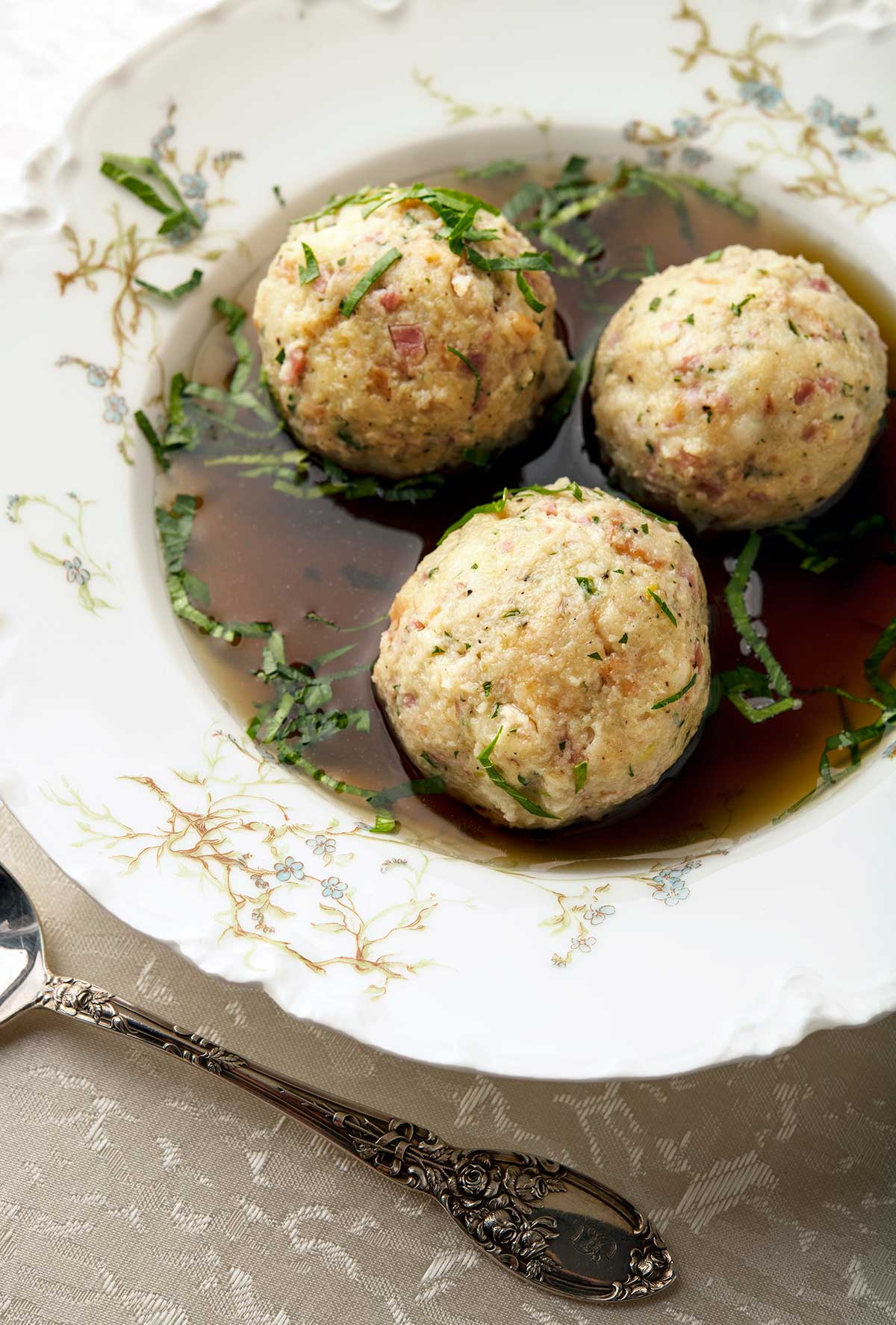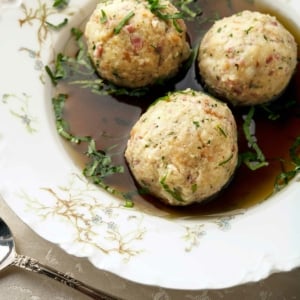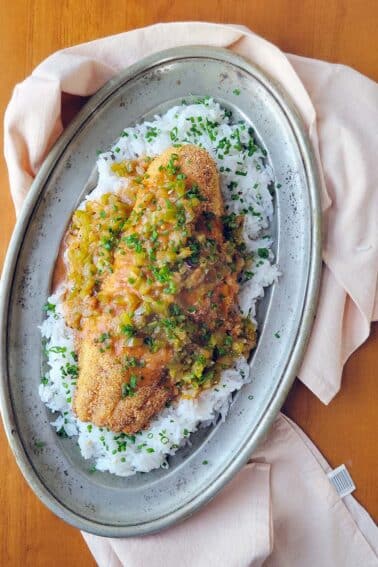As an Amazon Associate I earn from qualifying purchases.
Canederli are wintry, soulful, rich and filling dumplings from the Italian Alps. They are easy to make and are great served in broth, or with a variety of sauces.

At their core, canederli, pronounced can-uh-DARE-lee, are bread dumplings with other good things mixed in. They are a lot like the Bavarian dumplings in my recipe for roast venison, and this makes sense, since it’s not that far between Trentino in Italy, where these are best known, and Bavaria.
Round dumplings appear all over Central Europe, and Italy has its share; I also make a spinach dumpling — although I usually make these with nettles or lambsquarters — that hails from Northern Italy as well.
According to the bible of pasta, Oretta Zanini de Vita’s Encyclopedia of Pasta, canederli exist in countless forms across the north of Italy, from Lombardy to Fruili. Some of the ingredients she mentions sound thrilling.
- There is a form that is a quasi-fish ball, bound with pike or eel.
- Some are bread-and-liver dumplings, which makes me want to make some with fatty wild duck livers.
- Some canederli are made in part with buckwheat flour because that crop will grow in high Alpine valleys.
- Most include some cured meat, from salami to speck, the local ham. Mine contains that, as you’ll see below.
You can make canederli in two ways: Super large, cannonball-like rustic dumplings, where like one is a serving, as they do in Germany, or make them with finely chopped ingredients, smaller, so you can eat them like you would a meatball. I do the latter.
Making Canederli
Canederli always start with stale bread. These dumplings are icons of thrift in the mountains, where bread was traditionally only baked once a week, or less. You can use fresh bread if you don’t have an old loaf lying around.
The bread is stripped of its crust, torn into small chunks and soaked in milk until soft. While this is happening, you’re usually cooking some onions and garlic until they’re soft and chopping greens or herbs or mushrooms.
Whatever is going into the dumplings needs to be chopped small so they’ll hold together, especially any cured meat. I mince bits of ham — smoked or cured ham like speck or prosciutto, not the boiled stuff — and add that, too.
You squeeze out the excess milk in the bread, crack a couple eggs, and mix it all very well to form a paste that will adhere to itself. Form balls with wet hands, simmer in salty water or broth, and you’re good to go.
All in all, making canederli takes about a half-hour.
How to Serve Canederli
If you’re just whipping some up, you might just want to serve them Central European style, with butter and caramelized onions, maybe with the slightest drizzle of honey.
Mostly, however, you will serve canederli with broth. What broth is up to you. With these, I prefer a dark, rich broth made from mushrooms, game or beef.
In the pictures I am serving the dumplings with wild duck consommé. I love it because it is loaded with flavor, clear and pretty. But really any broth will do, and it will dictate the mood of your meal.
Try a tomato or a carrot consommé in summer or early fall. Use venison stock, or fish stock if you want, or even experiment with a flavorful shrimp stock or crab broth. Play with it.

Storing
Alas, canederli don’t store well. I mean you can, but they seem to become heavy and leaden when you reheat them. And because these dumplings are made from pantry ingredients that store well in themselves, and because they can be made fairly quickly, best to make a batch of canederli and just eat them.
If you liked this recipe, please leave a ⭐️⭐️⭐️⭐️⭐️ rating and a comment below; I’d love to hear how everything went. If you’re on Instagram, share a picture and tag me at huntgathercook.
Canederli
Ingredients
- 4 ounces stale bread, crusts removed (about 4 healthy slices)
- 1/2 cup milk (or broth)
- 2 tablespoons butter or olive oil
- 1/2 cup onion, minced
- 2 ounces speck, prosciutto or salami, minced
- 3 tablespoons minced parsley, or chard, spinach, etc.
- 3 tablespoons finely grated parmesan cheese
- 1/4 teaspoon nutmeg
- 1/4 teaspoon white pepper
- 1/2 teaspoon salt
- 1 or 2 eggs, lightly beaten
- flour (see below)
Instructions
- Tear the bread into bits and put in a bowl with the milk. Squash it all down and let this soak while you chop onions, parsley and the meat.
- While the bread is soaking, sauté the minced onion in the butter or olive oil until soft. It's OK if it browns a bit, but you don't need it caramelized. Remove it from the pan and put it into a large bowl to cool.
- Have a large pot of simmering water ready, with enough salt to make it taste like the sea.
- Squeeze out excess milk from the bread and add it to the bowl with the onions. Add the minced meat, parsley, cheese, nutmeg, pepper and salt. Mix well. Stir in the eggs and work this mixture well, like its a dough. If it's too wet, add flour 1 tablespoon at a time until it comes together like a proper dough you can roll balls out of.
- Roll out round dumplings with your palms. Size is up to you, but I like to make them the size of a walnut in the shell; they expand a bit when cooking. Do this with all the dough, then gently put them in the simmering water.
- The canaderli are done about a minute or two after they float to the top. Serve by giving everyone a few dumplings in a bowl, then pouring some rich broth over them. Chopped herbs like parsley, lovage, savory, or sage are nice here.
Notes
Nutrition
Nutrition information is automatically calculated, so should only be used as an approximation.






can you make these ahead of time?
Mark: Yes, but I’d make them no more than a day before. They can get heavy and stodgy if left too long.
Yum! Looking at the nettles version too!
Thank you! love those canederli… In the Alto Adige you usually order a “Tris” which is one with speck, a green (spinach) one and a red beet one. Served “in brodo” or just with a drizzle of clarified butter and maybe some sage. Quite beautiful on the plate. There is canederli made with semolino instead of bread which is nice with some prosciutto in it. This version can also be baked “al forno” which is delicious. I live in Switzerland and will often make the pilgrimage to the Dolomiti just eat them.
Susan: So cool! I did not know that about the trio, but it sounds fantastic.
I was amazed when I found this recipe on line! My family has been making a very similar recipe we call Canidoli for years! My ancesters came to the USA from the Tyrol/Dolomite mountain area of Italy in the early 1900’s. Our version of this is to simmer a small beef chuck roast in water with onion and celery leaves for flavor. When the roast is done and cooled, we cut into little pieces. We soak stale bread in milk like you do, squeeze it out, then mix it in the beef along with pieces of salami, diced onion (we don’t saute it first), diced celery, eggs, flour (if needed), and salt and pepper. We roll the dumplings a little bigger than a golf ball and cook them in the beef broth. I always wondered why other Italians never heard of this so I started looking it up on line and found it was more a German or Austrian (even Russian) dish. This is one of our family’s favorite meals.
My Austrian grandparents made this and it sounds similar to what you describe. They came to this country in 1903 from an area called “Rameno” which I don’t quite know what that is but there is a river by that name I think. So I always assumed it was an Austrian dish. My aunt was the one to always make it after the grandparents passed. I had it many times but only at my aunt’s home.
Another winner, as usual. Did with wifes stale sourdough and finely diced italian salami, served in a clear turkey broth. A-grade monday night stuff.
cheers.
This sounds lovely as do all your recipes. I’ve made several. This one’s name made me smile— I asked a friend what kind of dog he had in the back of his truck . He said it was from Hoonah and it was a Cunardly. Eh?
“Cunardly tell what it is.” ??
Another awesome recipe. Whipped these up tonight with some venison stock I had laying around, and some prosciutto. It was absolutely delicious.
Hi Hank, this looks great. Would ground (deer) venison work? Thanks
Bill: Maybe? It’s not a meatball, so I am not sure how much you’d use.
Hank,
Will your German Bacon work here? It’s been smoked to 160F internal. It’s a staple around here like flour and salt, love the stuff.
Ted
Ted: Yes, it will.